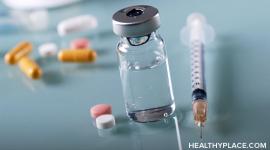Eating and Diabetes: A Diet for Diabetes

Sticking to a diet for diabetes keeps blood glucose levels on target. Learn about eating and diabetes, diet and diabetes.
Healthy Eating and Diabetes:
- Eating and Diabetes
- Blood Glucose Levels
- Your Diabetes Medicines
- Your Physical Activity Plan
- The Diabetes Food Pyramid
- Starches
- Vegetables
- Fruits
- Milk
- Meat and Meat Substitutes
- Fats and Sweets
- Alcoholic Drinks
- Your Meal Plan
- Measuring Your Food
- When You're Sick
- Where can I get more information?
Eating and Diabetes
You can take good care of yourself and your diabetes by learning
- what to eat
- how much to eat
- when to eat
Making wise food choices can help you
- feel good every day
- lose weight if you need to
- lower your risk for heart disease, stroke, and other problems caused by diabetes
Healthful eating helps keep your blood glucose, also called blood sugar, in your target range. Physical activity and, if needed, diabetes medicines also help. The diabetes target range is the blood glucose level suggested by diabetes experts for good health. You can help prevent health problems by keeping your blood glucose levels on target.
Blood Glucose Levels
What should my blood glucose levels be?
Target Blood Glucose Levels for People with Diabetes
| Before meals | 80 to 130 mg/dL |
| 1 to 2 hours after the start of a meal | less than 180 mg/dL |
Talk with your healthcare provider about your blood glucose target levels.
Ask your doctor how often you should check your blood glucose on your own. Also ask your doctor for an A1C test at least twice a year. Your A1C number gives your average blood glucose for the past 3 months. The results from your blood glucose checks and your A1C test will tell you whether your diabetes care plan is working.
How can I keep my blood glucose levels on target?
You can keep your blood glucose levels on target by:
- making wise food choices
- being physically active
- taking medicines if needed
For people taking certain diabetes medicines, following a schedule for meals, snacks, and physical activity is best. However, some diabetes medicines allow for more flexibility. You'll work with your health care team to create a diabetes plan that's best for you.
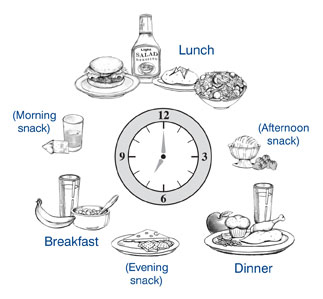
Your Diabetes Medicines
What you eat and when you eat affect how your diabetes medicines work. Talk with your doctor or diabetes teacher about when to take your diabetes medicines.
Your Physical Activity Plan to Help Manage Diabetes
What you eat and when also depend on how much you exercise. Physical activity is an important part of staying healthy and controlling your blood glucose. Keep these points in mind:
- Talk with your doctor about what types of exercise are safe for you.
- Make sure your shoes fit well and your socks stay clean and dry. Check your feet for redness or sores after exercising. Call your doctor if you have sores that do not heal.
- Warm up and stretch for 5 to 10 minutes before you exercise. Then cool down for several minutes after you exercise. For example, walk slowly at first, stretch, and then walk faster. Finish up by walking slowly again.
- Ask your doctor whether you should exercise if your blood glucose level is high.
- Ask your doctor whether you should have a snack before you exercise.
- Know the signs of low blood glucose, also called hypoglycemia. Always carry food or glucose tablets to treat low blood glucose.
- Always wear your medical identification or other ID.
- Find an exercise buddy. Many people find they are more likely to do something active if a friend joins them.
Low Blood Glucose (Hypoglycemia)
Low blood glucose can make you feel shaky, weak, confused, irritable, hungry, or tired. You may sweat a lot or get a headache. If you have these symptoms, check your blood glucose. If it is below 80, have one of the following right away:
- 3 or 4 glucose tablets
- 1 serving of glucose gel—the amount equal to 15 grams of carbohydrate
- 1/2 cup (4 ounces) of any fruit juice
- 1/2 cup (4 ounces) of a regular (not diet) soft drink
- 1 cup (8 ounces) of milk
- 5 or 6 pieces of hard candy
- 1 tablespoon of sugar or honey
After 15 minutes, check your blood glucose again. If it's still too low, have another serving. Repeat these steps until your blood glucose level is 80 or higher. If it will be an hour or more before your next meal, have a snack as well.
The Diabetes Food Pyramid (Diet and Diabetes)
The diabetes food pyramid can help you make wise food choices. It divides foods into groups, based on what they contain. Eat more from the groups at the bottom of the pyramid, and less from the groups at the top. Foods from the starches, fruits, vegetables, and milk groups are highest in carbohydrate. They affect your blood glucose levels the most.
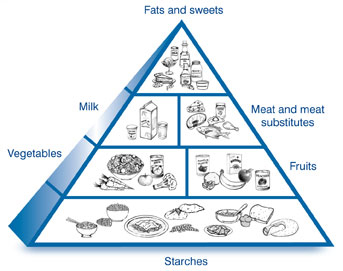
The diabetes food pyramid can help you make wise food choices. It divides foods into groups, based on what they contain. Eat more from the groups at the bottom of the pyramid, and less from the groups at the top. Foods from the starches, fruits, vegetables, and milk groups are highest in carbohydrate. They affect your blood glucose levels the most. See "How much should I eat each day" below to find out how much to eat from each food group.
How much should I eat each day?
Have about 1,200 to 1,600 calories a day if you are a
- small woman who exercises
- small or medium-sized woman who wants to lose weight
- medium-sized woman who does not exercise much
| Choose this many servings from these food groups to have 1,200 to 1,600 calories a day: | |
| 6 starches | 2 milks |
| 3 vegetables | 4 to 6 ounces meat and meat substitutes |
| 2 fruits | up to 3 fats |
Talk with your diabetes teacher about how to make a meal plan that fits the way you usually eat, your daily routine, and your diabetes medicines. Then make your own plan.
Have about 1,600 to 2,000 calories a day if you are a
- large woman who wants to lose weight
- small man at a healthy weight
- medium-sized man who does not exercise much
- medium-sized or large man who wants to lose weight
| Choose this many servings from these food groups to have 1,600 to 2,000 calories a day: | |
| 8 starches | 2 milks |
| 4 vegetables | 4 to 6 ounces meat and meat substitutes |
| 3 fruits | up to 4 fats |
Talk with your diabetes teacher about how to make a meal plan that fits the way you usually eat, your daily routine, and your diabetes medicines. Then make your own plan.
Have about 2,000 to 2,400 calories a day if you are a
- medium-sized or large man who exercises a lot or has a physically active job
- large man at a healthy weight
- medium-sized or large woman who exercises a lot or has a physically active job
| Choose this many servings from these food groups to have 2,000 to 2,400 calories a day: | |
| 10 starches | 2 milks |
| 4 vegetables | 5 to 7 ounces meat and meat substitutes |
| 4 fruits | up to 5 fats |
Talk with your diabetes teacher about how to make a meal plan that fits the way you usually eat, your daily routine, and your diabetes medicines. Then make your own plan.
Starches
Starches are bread, grains, cereal, pasta, and starchy vegetables like corn and potatoes. They provide carbohydrate, vitamins, minerals, and fiber. Whole grain starches are healthier because they have more vitamins, minerals, and fiber.
Eat some starches at each meal. Eating starches is healthy for everyone, including people with diabetes.
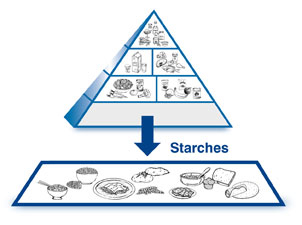
Examples of starches are
- bread
- pasta
- corn
- pretzels
- potatoes
- rice
- crackers
- cereal
- tortillas
- beans
- yams
- lentils
How much is a serving of starch?
Examples of 1 serving:

Examples of 2 servings:

Examples of 3 servings:

If your plan includes more than one serving at a meal, you can choose different starches or have several servings of one starch. A diabetes teacher can help you with your meal plan.
What are healthy ways to eat starches?
- Buy whole grain bread and cereal.
- Eat fewer fried and high-fat starches such as regular tortilla chips and potato chips, french fries, pastries, or biscuits. Try pretzels, fat-free popcorn, baked tortilla chips or potato chips, baked potatoes, or low-fat muffins.
- Use low-fat or fat-free plain yogurt or fat-free sour cream instead of regular sour cream on a baked potato.
- Use mustard instead of mayonnaise on a sandwich.
- Use low-fat or fat-free substitutes such as low-fat mayonnaise or light margarine on bread, rolls, or toast.
- Eat cereal with fat-free (skim) or low-fat (1%) milk.
Vegetables
Vegetables provide vitamins, minerals, and fiber. They are low in carbohydrate.
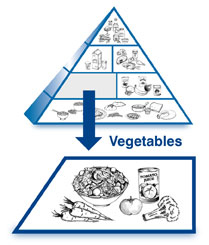
Examples of vegetables are
|
|
How much is a serving of vegetables?
Examples of 1 serving:

Examples of 2 servings:

Examples of 3 servings:
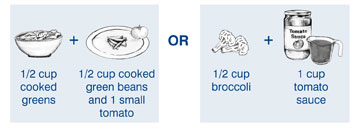
If your plan includes more than one serving at a meal, you can choose several types of vegetables or have two or three servings of one vegetable. A diabetes teacher can help you with your meal plan.
What are healthy ways to eat vegetables?
- Eat raw and cooked vegetables with little or no fat, sauces, or dressings.
- Try low-fat or fat-free salad dressing on raw vegetables or salads.
- Steam vegetables using water or low-fat broth.
- Mix in some chopped onion or garlic.
- Use a little vinegar or some lemon or lime juice.
- Add a small piece of lean ham or smoked turkey instead of fat to vegetables when cooking.
- Sprinkle with herbs and spices.
- If you do use a small amount of fat, use canola oil, olive oil, or soft margarine (liquid or tub types) instead of fat from meat, butter, or shortening.
Fruits
Fruits provide carbohydrate, vitamins, minerals, and fiber.
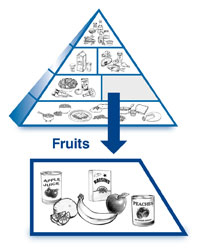
Examples of fruits include
- apples
- fruit juice
- strawberries
- dried fruit
- grapefruit
- bananas
- raisins
- oranges
- watermelon
- peaches
- mango
- guava
- papaya
- berries
- canned fruit
How much is a serving of fruit?
Examples of 1 serving:

Examples of 2 servings:
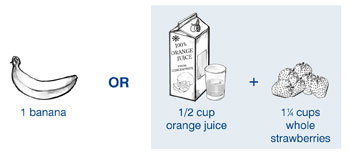
If your plan includes more than one serving at a meal, you can choose different types of fruit or have several servings of one fruit. A diabetes teacher can help you with your meal plan.
What are healthy ways to eat fruits?
- Eat fruits raw or cooked, like juice with no sugar added, canned in their own juice, or dried.
- Buy smaller pieces of fruit.
- Choose pieces of fruit more often than fruit juice. Whole fruit is more filling and has more fiber.
- Save high-sugar and high-fat fruit desserts such as peach cobbler or cherry pie for special occasions.
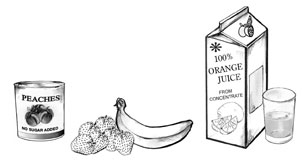
Milk
Milk provides carbohydrate, protein, calcium, vitamins, and minerals.
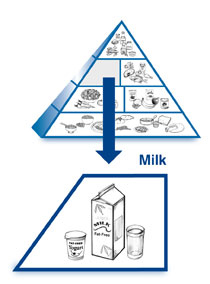
How much is a serving of milk?
Examples of 1 serving:
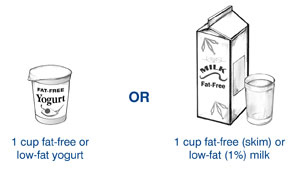
Note: If you are pregnant or breastfeeding, have four to five servings of milk each day.
What are healthy ways to have milk?
- Drink fat-free (skim) or low-fat (1%) milk.
- Eat low-fat or fat-free fruit yogurt sweetened with a low-calorie sweetener.
- Use low-fat plain yogurt as a substitute for sour cream.
Meat and Meat Substitutes
The meat and meat substitutes group includes meat, poultry, eggs, cheese, fish, and tofu. Eat small amounts of some of these foods each day.
Meat and meat substitutes provide protein, vitamins, and minerals.
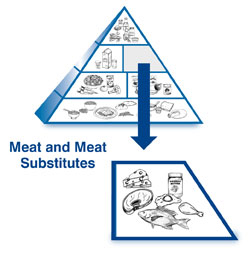
Examples of meat and meat substitutes include
- chicken
- beef
- fish
- canned tuna or other fish
- eggs
- peanut butter
- tofu
- cottage cheese
- cheese
- pork
- lamb
- turkey
How much is a serving of meat and meat substitutes?
Meat and meat substitutes are measured in ounces. Here are examples.
Examples of 1-ounce serving:
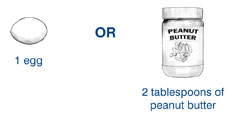
Examples of 2-ounce serving:

Examples of 3-ounce serving:

*Three ounces of meat (after cooking) is about the size of a deck of cards.
What are healthy ways to eat meat and meat substitutes?
- Buy cuts of beef, pork, ham, and lamb that have only a little fat on them. Trim off the extra fat.
- Eat chicken or turkey without the skin.
- Cook meat and meat substitutes in low-fat ways:
- broil
- grill
- stir-fry
- roast
- steam
- microwave
- To add more flavor, use vinegars, lemon juice, soy sauce, salsa, ketchup, barbecue sauce, herbs, and spices.
- Cook eggs using cooking spray or a non-stick pan.
- Limit the amount of nuts, peanut butter, and fried foods you eat. They are high in fat.
- Check food labels. Choose low-fat or fat-free cheese.
Fats and Sweets
Limit the amount of fats and sweets you eat. Fats and sweets are not as nutritious as other foods. Fats have a lot of calories. Sweets can be high in carbohydrate and fat. Some contain saturated fats, trans fats, and cholesterol that increase your risk of heart disease. Limiting these foods will help you lose weight and keep your blood glucose and blood fats under control.
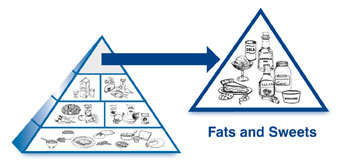
Examples of fats include
- salad dressing
- oil
- cream cheese
- butter
- margarine
- mayonnaise
- avocado
- olives
- bacon
Examples of sweets include
- cake
- ice cream
- pie
- syrup
- cookies
- doughnuts
How much is a serving of sweets?
Examples of 1 serving:
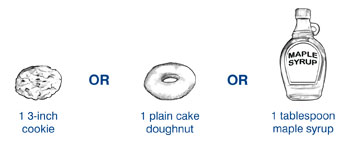
How much is a serving of fat?
Examples of 1 serving:

Examples of 2 servings:
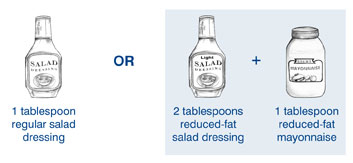
How can I satisfy my sweet tooth?
Try having sugar-free popsicles, diet soda, fat-free ice cream or frozen yogurt, or sugar-free hot cocoa mix.
Other tips:
- Share desserts in restaurants.
- Order small or child-size servings of ice cream or frozen yogurt.
- Divide homemade desserts into small servings and wrap each individually. Freeze extra servings.
Remember, fat-free and low-sugar foods still have calories. Talk with your diabetes teacher about how to fit sweets into your meal plan.
Alcoholic Drinks
Alcoholic drinks have calories but no nutrients. If you have alcoholic drinks on an empty stomach, they can make your blood glucose level go too low. Alcoholic drinks also can raise your blood fats. If you want to have alcoholic drinks, talk with your doctor or diabetes teacher about how much to have.
Your Meal Plan
Plan your meals and snacks for one day. Work with your diabetes teacher if you need help.
|
Breakfast |
||
| Food Group | Food | How Much |
|
Snack |
||
| Food Group | Food | How Much |
|---|---|---|
|
Lunch |
||
| Food Group | Food | How Much |
|
Snack |
||
| Food Group | Food | How Much |
|
Dinner |
||
| Food Group | Food | How Much |
|
Snack |
||
| Food Group | Food | How Much |
Measuring Your Food
To make sure your food servings are the right size, you can use
- measuring cups
- measuring spoons
- a food scale
Or you can use the guide below. Also, the Nutrition Facts label on food packages tells you how much of that food is in one serving.
Guide to Sensible Serving Sizes
| This much | is the same as |
 |
3 ounces 1 serving of meat, chicken, turkey, or fish |
 |
1 cup 1 serving of
|
 |
½ cup 1 serving of
|
 |
1 ounce 1 serving of
|
 |
1 tablespoon 1 serving of
|
 |
1 teaspoon 1 serving of
|
When You're Sick
Take care of yourself when you're sick. Being sick can make your blood glucose go too high. Tips on what to do include the following:
- Check your blood glucose level every 4 hours. Write down the results.
- Keep taking your diabetes medicines. You need them even if you can't keep food down.
- Drink at least one cup (8 ounces) of water or other calorie-free, caffeine-free liquid every hour while you're awake.
- If you can't eat your usual food, try drinking juice or eating crackers, popsicles, or soup.
- If you can't eat at all, drink clear liquids such as ginger ale. Eat or drink something with sugar in it if you have trouble keeping food down because you still need calories. If you can't eat enough, you increase your risk of low blood glucose, also called hypoglycemia.
- In people with type 1 diabetes, when blood glucose is high, the body produces ketones. Ketones can make you sick. Test your urine or blood for ketones if
- your blood glucose is above 240
- you can't keep food or liquids down
- Call your healthcare provider right away if
- your blood glucose has been above 240 for longer than a day
- you have ketones
- you feel sleepier than usual
- you have trouble breathing
- you can't think clearly
- you throw up more than once
- you've had diarrhea for more than 6 hours
Where can I get more information?
Diabetes Teachers (nurses, dietitians, pharmacists, and other health professionals)
To find a diabetes teacher near you, call the American Association of Diabetes Educators toll-free at 1-800-TEAMUP4 (832-6874) or see www.diabeteseducator.org and click on "Find an Educator."
Recognized Diabetes Education Programs (teaching programs approved by the American Diabetes Association)
To find a program near you, call the American Diabetes Association toll-free at 1-800-DIABETES (342-2383) or see professional.diabetes.org/ERP_List.aspx on the Internet.
Dietitians
To find a dietitian near you, call the American Dietetic Association's National Center for Nutrition and Dietetics toll-free at 1-800-877-1600 or see www.eatright.org and click on "Find a Nutrition Professional."NIH Publication No. 08-5043
October 2007
APA Reference
Staff, H.
(2022, January 4). Eating and Diabetes: A Diet for Diabetes, HealthyPlace. Retrieved
on 2025, December 25 from https://www.healthyplace.com/diabetes/treatments/eating-and-diabetes-a-diet-for-diabetes


